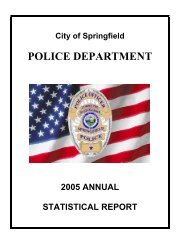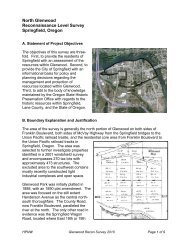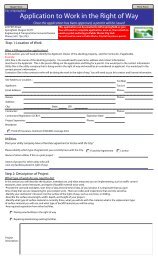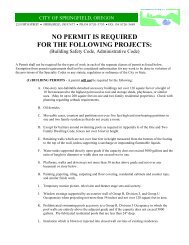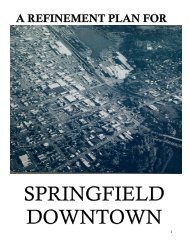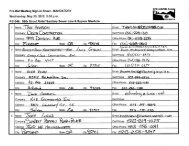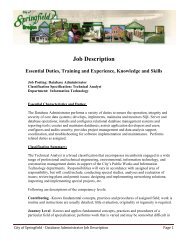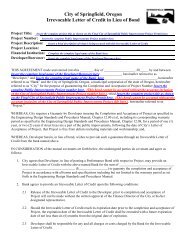WW Project Pages.xlsx - City of Springfield
WW Project Pages.xlsx - City of Springfield
WW Project Pages.xlsx - City of Springfield
Create successful ePaper yourself
Turn your PDF publications into a flip-book with our unique Google optimized e-Paper software.
Buffer multiple family development from single family development and residential land fromcommercial land through site plan review;Work with Willamalane to provide adequate park and recreational facilities to residents;Discourage through truck traffic in residentially designated areas;Encourage bicycle path into the design <strong>of</strong> recreational and new residential facilities.SECTION IIFUNDINGCAPITAL PROJECT FUNDINGThere are limited sources <strong>of</strong> funding for capital activity. The principal sources include 1) revenuesderived from user fees or those taxes (such as fuel taxes) which function like user fees; 2) SystemsDevelopment Charges (SDCs), which are designed to recover from development the cost impact thatdevelopment has on public infrastructure; 3) external contributions, in the form <strong>of</strong> intergovernmentalgrants or loans, payments by developers for specific improvements, and assessments <strong>of</strong> benefittedproperty owners, also for specific improvements; and 4) other sources such as revenue leveraged by taxincrement financing in the <strong>City</strong>’s two urban renewal districts, and revenue from internally generatedcharges, which at present play a minor role in capital project funding. The <strong>City</strong> <strong>of</strong> <strong>Springfield</strong>’s accountsfor these four revenue sources are in special revenue or enterprise funds, such as the Street CapitalFund, Systems Development Charges funds, and the Wastewater and Drainage Capital funds. The fundsused by the <strong>City</strong> to record and account for capital funding are listed following this discussion, along withthe limitations imposed by local, state, or federal laws associated with the funding source.USER FEESEach <strong>of</strong> the three public infrastructure systems (streets, sanitary sewers, and storm drainage) is fundedby fees paid by those who use the system. In the case <strong>of</strong> the local wastewater and storm drainagesystems those fees are directly billed to users. In the case <strong>of</strong> the transportation system those fees arecollected in the form <strong>of</strong> taxes on motor fuel at both the state and local level, and by state fees forlicensing and registration <strong>of</strong> drivers and vehicles, as well as weight mile taxes imposed on the truckingindustry.<strong>City</strong> Council policy calls for a portion <strong>of</strong> those fees, in excess <strong>of</strong> that required for current operation <strong>of</strong> thesystems, to be devoted to preservation <strong>of</strong> the existing systems. However, in the past several years it hasbeen necessary to devote some portion <strong>of</strong> those revenues to fund expansion <strong>of</strong> the system, eitherthrough direct funding <strong>of</strong> capital activity or by funding debt service on revenue bonds. To date, the <strong>City</strong>has issued revenue bonds in 2009 to fund local wastewater capital activity, and in 2010 to fund stormdrainage capital projects. This level <strong>of</strong> capital support has produced circumstances which have led tosubstantial increases in user fees for both systems, and created concerns that user fees might beapproaching levels which test the traditional level <strong>of</strong> citizen support. It is also important to note that theCouncil has discussed a further debt issue in FY 2013 to fund local wastewater needs.Page 142012-2016 Capital Improvement Program



